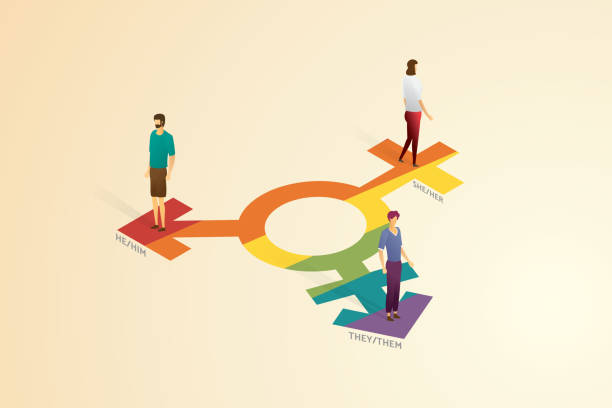The term gender dysphoria is widely discussed in the context of transgender and non-binary people. Often the term is loaded with prejudice and assumptions, and if not understood with all its nuances, it also leads to stereotypical understanding and medical essentialisation of transgender and non-binary people.
With the increased conversation about gender diversity and individuals finding voices to express their gender identity and expression beyond the binary, it is crucial to understand various aspects of “gender dysphoria”.
The word dysphoria is generally used to describe distress, discomfort, or unease. For transgender people, this kind of distress may be associated with our gender, our bodies, how those around us perceive our gender, and how our existence is perceived in a gendered world. So it is often given the name “gender dysphoria”.

The word dysphoria is generally used to describe distress, discomfort, or unease. For transgender people, this kind of distress may be associated with our gender, our bodies, how those around us perceive our gender, and how our existence is perceived in a gendered world. So it is often given the name “gender dysphoria”.
In 1980, gender dysphoria was included in the Diagnostic and Statistical Manual (DSM-III), published by the American Psychiatric Association (APA) for the classification of mental disorders. The diagnosis manual included a diagnostic group referred to as “Gender Identity Disorders” that comprised several conditions associated with gender identity.
The categorisation of dysphoria as a disorder has led to medicalisation and pathologisation of transgender persons, where the diagnosis is made by mental health care providers while treatment is usually done by endocrinologists. This happens because the medical approach is driven by the diagnosis-treatment model, which operates with the presumption that all transgender people have had, or currently have, dysphoria, which needs to be treated.
This is not true for all trans and non-binary people because dysphoria occurs for various reasons. Some transgender people feel dysphoria as overwhelming or all-encompassing, while others don’t have any dysphoria at all.

Since its first appearance in DSM, the definition of gender dysphoria has changed with each revision of the DSM. The term “gender dysphoria” replaced gender identity disorder in the DSM-5. The DSM-V says:
“Gender dysphoria refers to the distress that may accompany the incongruence between one’s experienced or expressed gender and one’s assigned gender. Although not all individuals will experience distress as a result of such incongruence, many are distressed if the desired physical interventions by means of hormones and/or surgery are not available.”
The categorisation of dysphoria as a disorder has led to medicalisation and pathologisation of transgender persons, where the diagnosis is made by mental health care providers while treatment is usually done by endocrinologists.
This was broadly considered a positive step, as it shifted the clinical focus from ‘who transgender people are’ (people with a disorder) to something “transgender people might experience”. The term is more appropriate because it implies a condition and not a disorder as its primary characteristic is the presence of feelings of discomfort with one’s physical appearance.
However, the emphasis on body and physical aspects in the DSM-V still keeps the requirement for medical legitimacy to the transgender experience intact. Without the narrative of dysphoria, it is almost impossible to access gender-affirming health care. When a transgender person wants to medically transition, they essentially have to prove that they are “really” trans, most often by exemplifying instances in which they have felt dysphoric, uncomfortable, upset, or in pain due to the gender experience.
The approach heavily depends on a before-after imagination that essentialises “medical transitioning” through gender-affirming surgery to legitimise trans-ness. Mental health professionals, doctors and other health professionals still believe that dysphoria is mandatory to be a transgender person. It erases the complex experience of trans and non-binary existence.
Dysphoria can be bodily, where the feeling of discomfort emerges from gendered body parts such as genitalia, body hair, etcetera. But dysphoria can also be social, which often does not make it into the medical understanding of dysphoria. Social dysphoria occurs because the world operates in binaries and does not accommodate the experiences of trans and non-binary people in terms of language, space and logistics.
Gendered physical spaces like toilets, airport and metro security checks, and college hostels induce discomfort by imposing gender binary upon trans and non-binary people. Similarly, gendered pronouns and terms, e.g., he/she, girls/boys, son/daughter, sir/madam, etcetera, also cause discomfort among people who don’t associate with these binaries.
Even the presence of legal documents such as passports, examination forms, etcetera, which require putting binary gender markers in them, can also cause dysphoria in trans and non-binary people by erasing their identity.
One of the ways to address gender dysphoria can be by reducing barriers for transgender people to access gender-affirming health care such as surgeries, hormone therapy and queer affirmative mental health care, etcetera. We must work to ensure that every trans person with or without dysphoria has access to all spaces of care without medical gatekeeping and without reducing them to mere bodies.
Also read: What Is Gender Dysphoria?: Addressing The Conflict Between Biological Sex And Gender Identity
Along with that, creating an enabling environment for trans and non-binary people to express their gender freely can help them cope with their gender dysphoria. An enabling environment would mean not only starting complex conversations about the experience of transgender and non-binary people but would also require systematically divesting from gender binary in all social spheres.
We must strive for spaces where a response to dysphoria is making society more accessible, universal and transgender-friendly rather than trying to fundamentally define and limit what “transness” is.
Also read: Is Gender Transition A Need Or A Wish?
Biraja is a researcher. They have been actively engaging with the transgender community in Odisha through rights-based advocacy. They are also a member of the #BaateinUnlocked advisory committee, which aims to unlock and open conversations on diverse issues related to youth and their sexual and reproductive health. They have special interests in labour rights, gender justice, and universal public services. While not working, they can be found imposing a genderless utopia on their friends over any random conversation.
Featured image source: Unsplash






Excellent Biraja, very informative. It gives an insight into how the gender spectrum needs to include dysphoria as an entire curriculum especially in counselling and mental health. Keep writing. ✊🏼